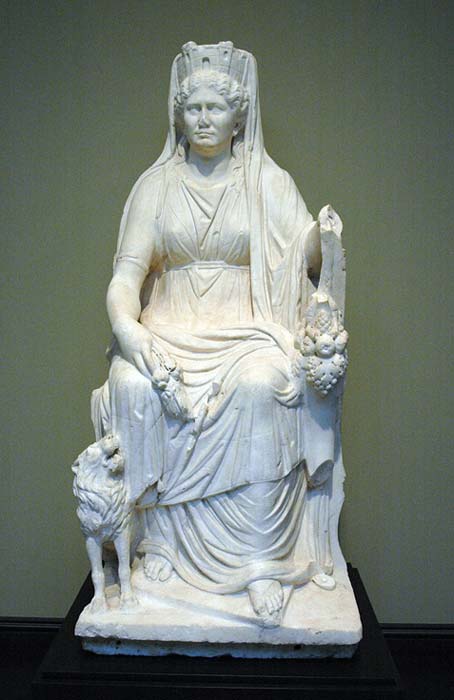
The Mother of all Gods: The Phrygian Cybele
A goddess of ecstatic and chthonic reproductive mysteries, Cybele was the primary mother goddess of ancient Anatolia, and Phrygia's only known goddess thus far. She was a "Mistress of Animals", "Great Mother" and "Mother of the Mountain" and it appears that Cybele was adopted by the Greeks in Asia Minor (modern day Turkey), and then adapted as she spread from there to mainland Greece, followed by Rome.
In Phrygia, no records remain concerning her cult and worship, though there are numerous statues of overweight, seated women that archaeologists believe represent Cybele. Often she is also portrayed giving birth, indicative of her Mother Goddess status.

Figurine of a seated Mother Goddess flanked by two lionesses found at Çatalhöyük (about 6000-5500 BC), Museum of Anatolian Civilizations in Ankara. (CC BY SA 2.5) Many say this is one of the earliest representations of Cybele.
Mother of the Mountain
Phrygian evidence for Cybele is made up of archaeological data in the form of rock carvings and excavated evidence from her principal cult site at Pessinus in the modern day Eskişehir province of Turkey. One such carving believed to reference Cybele calls her the "Mother of the mountain", a name which reveals her true Anatolian origins, as goddesses in Anatolia were often associated with specific mountains. Later, the Greeks and Romans kept better documentation of her cult, though much of her still remains a mystery.
- Vibrations and sounds may have enhanced worship of Great Goddess Cybele
- The Secret of Gobekli Tepe: Cosmic Equinox and Sacred Marriage - Part 1
- Everything he Touched Turned to Gold: The Myth and Reality of King Midas

The eroded rock-statue of "Mother of the Gods" (see text) at Mount Sipylus. (Public Domain)
Cybele has components of various mother goddesses in ancient Greece: Gaia, Rhea, and Demeter, each notable in their own aspects. Gaia is the ancient Greek mother goddess, responsible for birthing the gods and various aspects of the cosmos with Uranus. Rhea plays a similar role in the universe as the mother of the Olympians with ancient roots in Minoan and Mycenaean traditions. And Demeter is the mother goddess among the Olympians who is directly responsible for the changing of the seasons and thus the fertility of the earth.
Her Consort Attis
Her consort is the Phrygian shepherd called Attis, and their relationship was recognized in ancient Greece and Rome, though there are likely Phrygian roots to his character as well. Attis is believed to be her younger mate, often considered to be a deity himself, though beneath the goddess. It is highly debated whether Attis arrived with Cybele or after her, tacked on by the later Greek and Roman followers.
During the Roman Empire, the myth circulated that Attis castrated a king and was thus castrated in turn, and left to die under a pine tree. His followers buried him and then castrated themselves in his honor. These followers developed into Cybele's cult of priests, called the Galli.

Roman Imperial Attis wearing a Phrygian cap and performing a cult dance. (Public Domain)
Attis' exact nature is as questionable as his status in relation to Cybele. According to the scholar Roller, "Attis" was a rather common name in Anatolia and associated with priestly activities. Therefore, it is also likely that Attis only obtained divine status among the Greeks, and that he was a mere shepherd in the Anatolian religion. It is also possible that Attis is not Cybele’s consort at all, but her attendant or a mendicant (as suggested by his name and lower status.)

Cybele and Attis (seated right, with Phrygian cap and shepherd's crook) in a chariot drawn by four lions, surrounded by dancing Corybantes (detail from the Parabiago plate.) (Public Domain)
Magna Mater
Cybele's Roman counterpart was more often referred to as Magna Mater, or "The Great Mother". Rome adopted Cybele during the Second Punic War, likely influenced by the dire conditions the war was expected to have on Rome. It was on the advice of the Sibylline oracle that Rome officially recognized Cybele as one of their foreign goddesses. As the Romans leveled Carthage, the Republic evidently saw her adoption as a very good move.
- Superweapon of the Ancient World: A History of Chariots - Part I
- The Grand and Sacred Temple of Artemis, A Wonder of the Ancient World
- The Palace of Diocletian: Roman Retirement Home and Palace Fortress of Croatia

Cybele enthroned, with lion, cornucopia and Mural crown. Roman marble. (Public Domain)
Romans also believed that Cybele was the primary goddess of the ancient city of Troy. The Romans considered the Trojan prince Aeneas to have been their predecessor, having settled in the location of Rome with the survivors of the war before the births of Romulus and Remus. It was even thought that Cybele provided Aeneas with shipbuilding materials. Thus, her adoption into the Roman pantheon would have been considered a unification of the past and present.
Top image: Cybele protects from Vesuvius the towns of Stabiae, Herculaneum, Pompeii and Resina (1832) by François-Édouard Picot. Source: Public Domain
By Ryan Stone
Bibliography
Burkert, Walter. Greek Religion. Harvard University Press: Harvard, 1982.
Henig, Martin. A Handbook of Roman Art: A comprehensive survey of all of the Roman world. Cornell University Press: New York, 1983.
Rodgers, Nigel. Life in Ancient Rome People and Places. Hermes House: London, 2006.
Roller, Lynn. In Search of God the Mother: The Cult of Anatolian Cybele. University of California Press: California, 1999.















